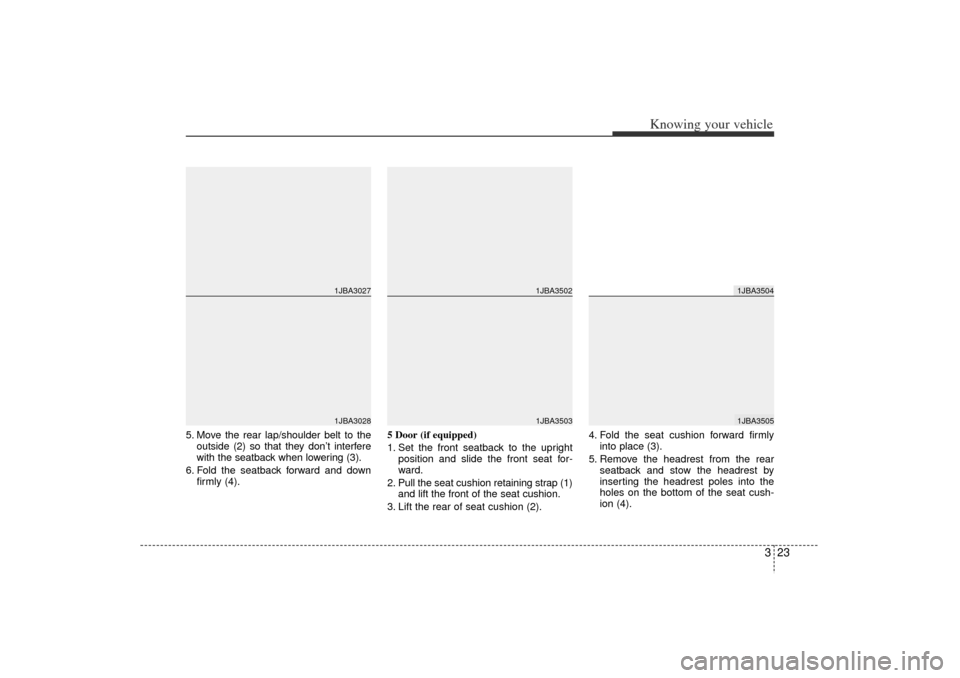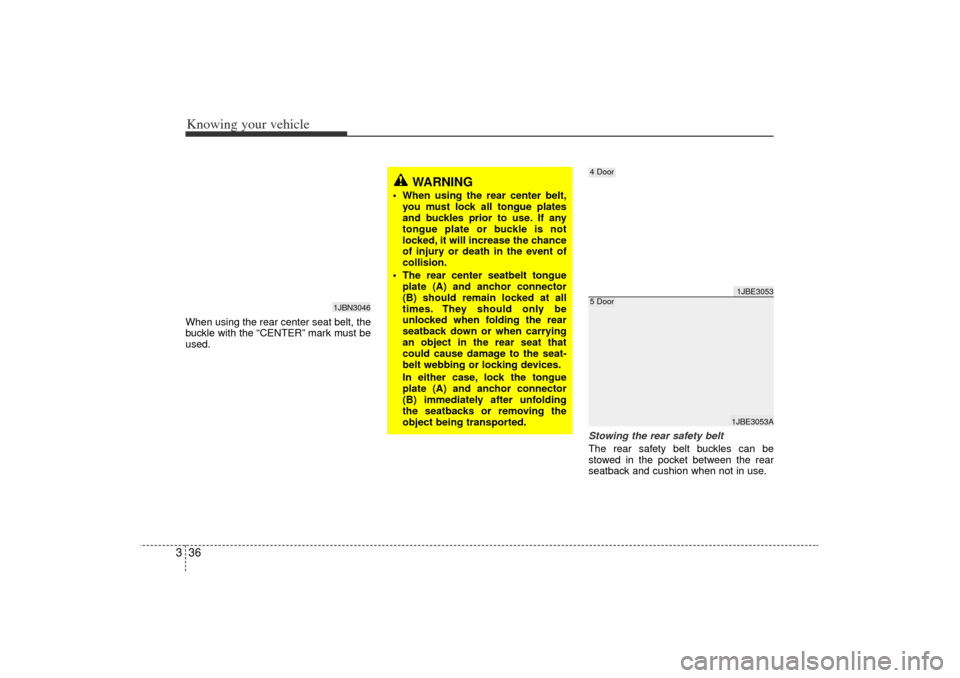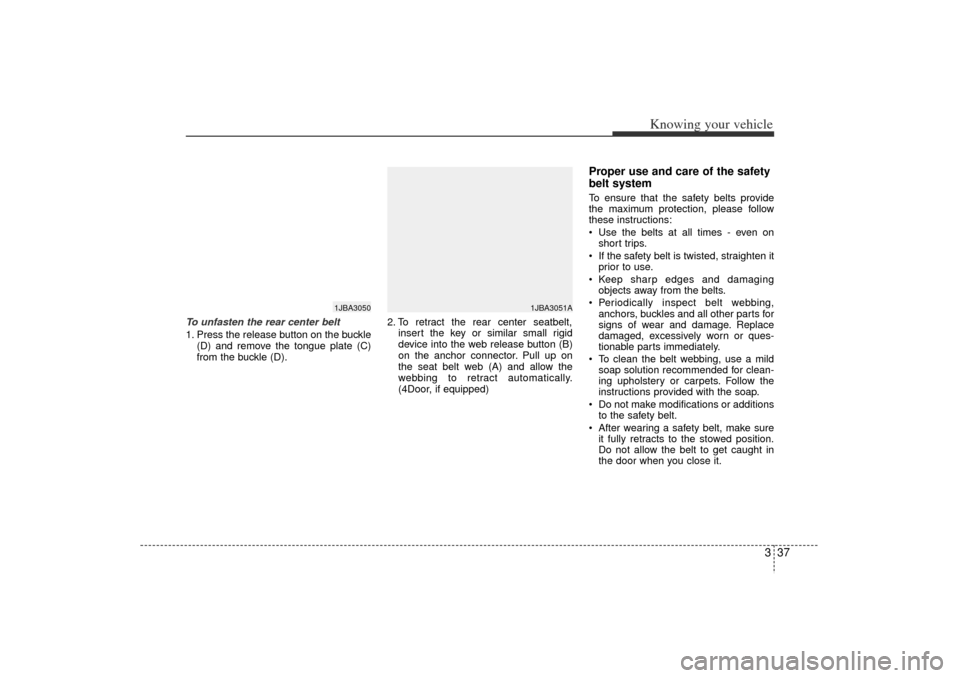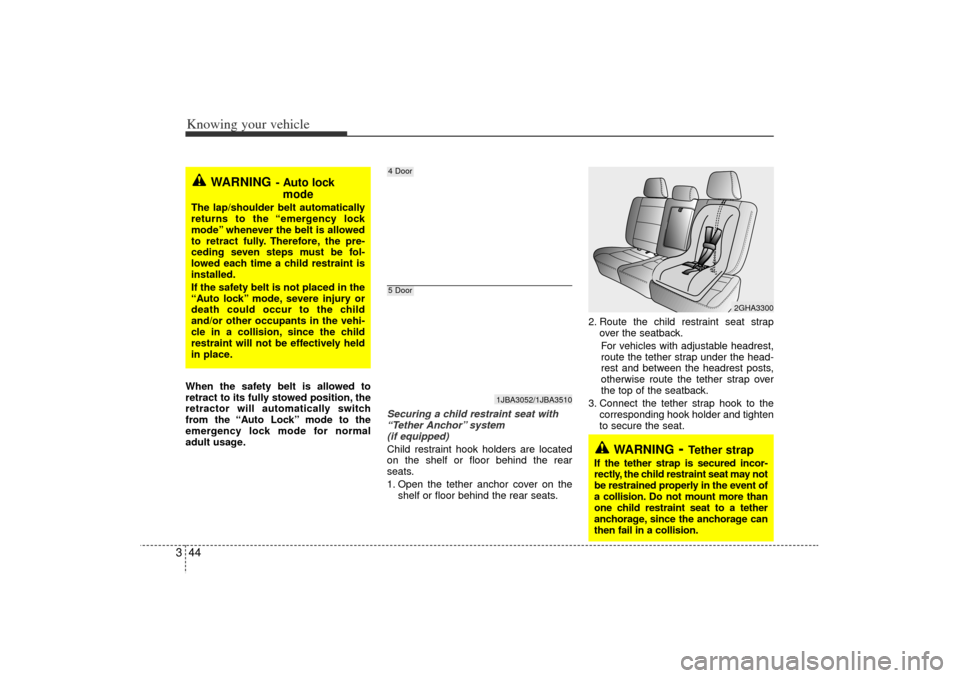2006 KIA Rio tow
[x] Cancel search: towPage 13 of 220

Knowing your vehicle43Operational distance may vary depend-
ing upon the area the transmitter is used
in. For example, if the vehicle is parked
near police stations, government and
public offices, broadcasting stations, mil-
itary installations, airports, or transmit-
ting towers, etc.
This device complies with Industry
Canada Standard RSS-210.Operation
is subject to the following two conditions:
1. This device may not cause interfer- ence, and
2. This device must accept any interfer- ence, including interference that may
cause undesired operation of the
device.
Battery replacementTransmitter uses a 3 volt lithium battery
which will normally last for several years.
When replacement is necessary, use the
following procedure.
1. Insert a slim tool into the slot and gen-tly pry open the transmitter center
cover (1).
2. Replace the battery with new one. When replacing the battery, make sure
the battery positive “+” symbol faces
up as indicated in the illustration.
3. Install the battery in the reverse order of removal.
✽ ✽NOTICEThe keyless entry system transmitter is
designed to give you years of trouble-
free use, however it can malfunction if
exposed to moisture or static electricity.
If you are unsure how to use your trans-
mitter or replace the battery, contact an
authorized Kia dealer. For replacement transmitters, see an
Authorized Kia Dealer for reprogram-
ming.✽ ✽NOTICE Using the wrong battery can cause the
transmitter to malfunction. Be sure to
use the correct battery.
To avoid damaging the transmitter, don't drop it, get it wet, or expose it to
heat or sunlight.
1KMA2003
1
WARNING
Changes or modifications not
expressly approved by the party
responsible for compliance could
void the user's authority to operate
the equipment.
JB CAN 3.qxd 7/29/05 8:56 AM Page 4
Page 17 of 220

Knowing your vehicle834. If all of the digits have been input suc-cessfully, you have to start the engine
within 30 seconds. If you attempt to
start the engine after 30 seconds, the
engine will not start and you will have
to input your password again.
After performing the limp home proce-
dure, you have to see an authorized Kia
dealer immediately to inspect and repair
your ignition key or immobilizer system.✽ ✽ NOTICEIf you cannot start your engine in spite
of limp home procedure, have your vehi-
cle towed by an authorized Kia dealer
for inspection and necessary repairs.
✽ ✽NOTICEThe transponder in your ignition key is
an important part of the immobilizer
system. It is designed to give years of
troublefree service, however you should
avoid exposure to moisture, static elec-
tricity and rough handling.
Immobilizer system malfunction could
occur.✽ ✽NOTICEDo not change, alter or adjust the
immobilizer system because it could
cause the immobilizer system to mal-
function and should only be serviced by
an authorized Kia dealer.
Malfunctions caused by improper alter-
ations, adjustments or modifications to
the immobilizer system are not covered
by your vehicle manufacturer warranty.
This device complies with Industry
Canada Standard RSS-210. Operation
is subject to the following two conditions:
1. This device may not cause interfer- ence, and
2. This device must accept any interfer- ence, including interference that may
cause undesired operation of the
device.
WARNING
Changes or modifications not
expressly approved by the party
responsible for compliance could
void the user's authority to operate
the equipment.
JB CAN 3.qxd 7/29/05 8:56 AM Page 8
Page 18 of 220

39
Knowing your vehicle
Operating door locks from out-
side the vehicle Turn the key toward rear of vehicle tounlock and toward front of vehicle to
lock.
If you lock the driver’s door with a key, all vehicle doors will lock automatically
(if equipped).
Turn the key to the right once to unlock the driver’s door and to the right twice
within 4 seconds to unlock all doors. (if
equipped)
If you lock the front passenger’s door with a key, all vehicle doors will lock
automatically. If your vehicle is equipped with a
remote keyless entry system, all vehi-
cle doors will unlock automatically
when you unlock the front passenger’s
door with a key (if equipped).
Doors can also be locked and unlocked with the transmitter (if
equipped).
Once the doors are unlocked, it may be opened by pulling the door handle.
When closing the door, push the door firmly by the hand. Make sure that
doors are closed securely.
To lock a door without the key, push down
on the front portion of the inside door
lock switch (1, if equipped) to the “LOCK”
position and close the door (2).
✽ ✽ NOTICEAlways remove the ignition key, engage
the parking brake, close all windows
and lock all doors when leaving your
vehicle unattended. ✽ ✽NOTICEIf the door is locked/unlocked multiple
times in rapid succession with either the
vehicle key or door lock switch, the sys-
tem may stop operating temporarily in
order to protect the circuit and prevent
damage to system components.
DOOR LOCKS
1JBA3004
Lock
Unlock
1JBN3005
JB CAN 3.qxd 7/29/05 8:56 AM Page 9
Page 32 of 220

323
Knowing your vehicle
5. Move the rear lap/shoulder belt to theoutside (2) so that they don’t interfere
with the seatback when lowering (3).
6. Fold the seatback forward and down firmly (4). 5 Door (if equipped)
1. Set the front seatback to the upright
position and slide the front seat for-
ward.
2. Pull the seat cushion retaining strap (1) and lift the front of the seat cushion.
3. Lift the rear of seat cushion (2). 4. Fold the seat cushion forward firmly
into place (3).
5. Remove the headrest from the rear seatback and stow the headrest by
inserting the headrest poles into the
holes on the bottom of the seat cush-
ion (4).
1JBA30271JBA3028
1JBA35021JBA3503
1JBA35041JBA3505
JB CAN 3.qxd 7/29/05 8:56 AM Page 23
Page 45 of 220

Knowing your vehicle36
3When using the rear center seat belt, the
buckle with the “CENTER” mark must be
used.
Stowing the rear safety belt
The rear safety belt buckles can be
stowed in the pocket between the rear
seatback and cushion when not in use.
1JBN3046
1JBE30531JBE3053A
4 Door5 Door
WARNING
When using the rear center belt,you must lock all tongue plates
and buckles prior to use. If any
tongue plate or buckle is not
locked, it will increase the chance
of injury or death in the event of
collision.
The rear center seatbelt tongue plate (A) and anchor connector
(B) should remain locked at all
times. They should only be
unlocked when folding the rear
seatback down or when carrying
an object in the rear seat that
could cause damage to the seat-
belt webbing or locking devices.
In either case, lock the tongue
plate (A) and anchor connector
(B) immediately after unfolding
the seatbacks or removing the
object being transported.
JB CAN 3.qxd 7/29/05 8:56 AM Page 36
Page 46 of 220

337
Knowing your vehicle
To unfasten the rear center belt
1. Press the release button on the buckle(D) and remove the tongue plate (C)
from the buckle (D). 2. To retract the rear center seatbelt,
insert the key or similar small rigid
device into the web release button (B)
on the anchor connector. Pull up on
the seat belt web (A) and allow the
webbing to retract automatically.
(4Door, if equipped)
Proper use and care of the safety
belt system To ensure that the safety belts provide
the maximum protection, please follow
these instructions:
Use the belts at all times - even onshort trips.
If the safety belt is twisted, straighten it prior to use.
Keep sharp edges and damaging objects away from the belts.
Periodically inspect belt webbing, anchors, buckles and all other parts for
signs of wear and damage. Replace
damaged, excessively worn or ques-
tionable parts immediately.
To clean the belt webbing, use a mild soap solution recommended for clean-
ing upholstery or carpets. Follow the
instructions provided with the soap.
Do not make modifications or additions to the safety belt.
After wearing a safety belt, make sure it fully retracts to the stowed position.
Do not allow the belt to get caught in
the door when you close it.
1JBA3050
1JBA3051A
JB CAN 3.qxd 7/29/05 8:56 AM Page 37
Page 53 of 220

Knowing your vehicle44
3When the safety belt is allowed to
retract to its fully stowed position, the
retractor will automatically switch
from the “Auto Lock” mode to the
emergency lock mode for normal
adult usage. Securing a child restraint seat with
“Tether Anchor” system
(if equipped)
Child restraint hook holders are located
on the shelf or floor behind the rear
seats.
1. Open the tether anchor cover on the
shelf or floor behind the rear seats. 2. Route the child restraint seat strap
over the seatback.
For vehicles with adjustable headrest,
route the tether strap under the head-
rest and between the headrest posts,
otherwise route the tether strap over
the top of the seatback.
3. Connect the tether strap hook to the corresponding hook holder and tighten
to secure the seat.
WARNING
- Auto lockmode
The lap/shoulder belt automatically
returns to the “emergency lock
mode” whenever the belt is allowed
to retract fully. Therefore, the pre-
ceding seven steps must be fol-
lowed each time a child restraint is
installed.
If the safety belt is not placed in the
“Auto lock” mode, severe injury or
death could occur to the child
and/or other occupants in the vehi-
cle in a collision, since the child
restraint will not be effectively held
in place.
1JBA3052/1JBA3510
4 Door5 Door
2GHA3300
WARNING
- Tether strap
If the tether strap is secured incor-
rectly, the child restraint seat may not
be restrained properly in the event of
a collision. Do not mount more than
one child restraint seat to a tether
anchorage, since the anchorage can
then fail in a collision.
JB CAN 3.qxd 7/29/05 8:56 AM Page 44
Page 58 of 220

349
Knowing your vehicle
Air bag system components The main components of your SRS are:
To indicate that your vehicle is
equipped with air bags, the correspon-
ding air bag covers are marked with
“SRS AIR BAG”.
- Driver’ s air bag
- Passenger’ s air bag
- Side air bag (if equipped)
- Curtain air bag (if equipped)
A diagnostic system that continually
monitors the system operation.
Air bag warning light to warn you of a
possible problem with the system.
Emergency power backup in case your
car’ s electrical system is disconnected
in a crash.
Driver’s air bag The driver’ s air bag is stored in the cen-
ter of the steering wheel.
(Continued)
Driver’s and front passenger’s air bag are designed to inflate only in
certain frontal collisions, and side
and curtain air bags are designed
to inflate in certain side impacts.
Frontal air bags are not designed
to provide protection in side
impacts, rear impacts, rollovers,
or less severe frontal collisions.
They will not provide protection
from later impacts in a multi-
impact collision.
If your vehicle has been subject- ed to flood conditions (e.g.
soaked carpeting/standing water
on the floor of the vehicle, etc.) or
if your vehicle has become flood
damaged in any way, do not
attempt to start the vehicle or put
the key in the ignition. Have the
vehicle towed to an authorized
Kia dealer for inspection and nec-
essary repairs.
Disregarding this precaution may
cause an unexpected air bag
deployment, which could result in
serious personal injury or death.
HLZ2061JBA3055
JB CAN 3.qxd 7/29/05 8:57 AM Page 49